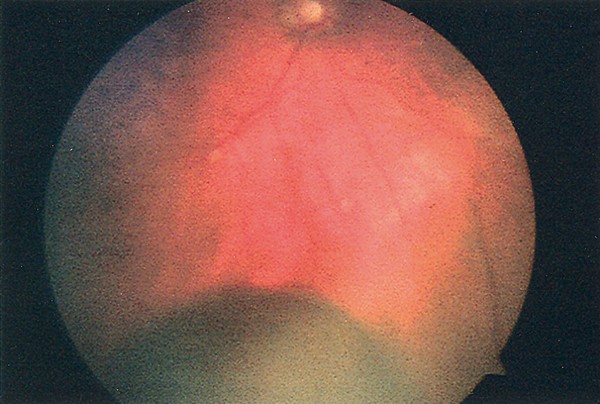
Spontaneous suprachoroidal haemorrhage following a valsalva manoeuvre
- Select a language for the TTS:
- UK English Female
- UK English Male
- US English Female
- US English Male
- Australian Female
- Australian Male
- Language selected: (auto detect) - EN
Play all audios:
MAIN Sir, Suprachoroidal haemorrhage is the accumulation of blood within the suprachoroidal space, which is a potential space situated between the choroid and the sclera.1 It has been
reported to occur in all types of intra-ocular procedures.2 Sudden hypotony is thought to be responsible for the haemorrhage.2 We describe a patient who developed a small SCH apparently
induced by a valsalva manoeuvre. CASE REPORT A 65-year-old gentleman presented to the eye casualty, after straining severely during a bowel movement. He felt a sudden ‘popping’ in his right
eye followed by pain and reduced vision in the right eye. There was no past or family history of eye disorders. He was known to be asthmatic and had recently developed a well-differentiated
prostatic cancer that was being treated with Indoramin (a selective alpha-blocker). There was no history of bleeding disorder; routine coagulation screening test results were normal. On
examination, the best corrected visual acuity was 6/24 in his right eye and 6/5 in his left eye. Intraocular pressures were 38 mmHg on the right and 12 mmHg on the left. There was epithelial
oedema affecting the lower half of the right cornea. The anterior chambers were deep and clear and both angles were open. Fundus examination of the left eye revealed an elevated, dark-brown
choroidal mass, approximately five disc diameters in size, located in the inferior half of the fundus (Figure 1). A contact ultrasonographic examination of the right eye confirmed the
presence of a choroidal lesion 4 mm in thickness (Figure 2). An intravenous acetazolamide 500 mg stat dose was given and the right intraocular pressure came down to 16 mmHg. One week later
his right cornea cleared and the right visual acuity had improved to 6/5. The swelling had reduced considerably and it had disappeared by the end of the second week. Ultrasound revealed
total resolution of the choroidal haemorrhage. We suggest that he suffered small choroidal haemorrhage caused by valsalva manoeuvre, and this resulted in a sudden increase in intraocular
pressure and subsequent corneal oedema. COMMENT A valsalva manoeuvre results in a rapid rise in intra-thoracic or intra-abdominal pressure against closed glottis. As a result of the absence
of valves in the venous system, this pressure is transmitted to the eye causing vessel wall rupture by an apparently excessive pressure gradient across the vessel wall.3 A spontaneous
suprachoroidal haemorrhage can result in angle closure glaucoma and corneal oedema secondary to forward displacement of the iris–lens diaphragm.5 In our case the angle was open at the time
of examination. Typically, patients experience a sudden onset of severe ocular pain with a subsequent loss of vision. Headache, nausea and vomiting may also accompany the ocular pain.1
Suprachoroidal haemorrhage after valsalva manoeuvre has been reported in patients either on systemic anti-coagulants, treated with streptokinase or in eyes with previous ocular surgery
(scleral buckle).2,3,4,5 To our knowledge, this is the first reported case of spontaneous choroidal haemorrhage in an individual who is not on any anticoagulants or has had no past history
of ocular surgery. REFERENCES * Chu TG, Green RL . Suprachoroidal haemorrhage. _Surv Ophthalmol_ 1999; 43(6): 471–486. Article CAS Google Scholar * van Meur JC, van den Bosch WA .
Suprachoroidal haemorrhage following a valsalva manoeuvre. _Arch Ophthalmol_ 1993; 111: 1025–1026. Article Google Scholar * Meyers SM, Foster RE . Choroidal haemorrhage after
valsalva's manoeuvre in eyes with a previous scleral buckle. _Ophthalm Surg_ 1995; 26(4): 216–217. CAS Google Scholar * Manuchehri K, Loo A, Ramchandani M, Kirby GR . Acute
suprachoroidal haemorrhage in a patient treated with streptokinase for myocardial infarction. _Eye_ 1999; 13(3): 685–686. Article Google Scholar * Alexandrakis G, Chaudhry NA, Liggett PE,
Weitzman M . Spontaneous suprachoroidal haemorrhage in age-related macular degeneration presenting as angle-closure glaucoma. _Retina_ 1998; 18(5): 485–486. Article CAS Google Scholar
Download references AUTHOR INFORMATION AUTHORS AND AFFILIATIONS * Princess Margaret Hospital, Okus Road, SN14JU, Swindon, UK T Hammam & C Madhavan Authors * T Hammam View author
publications You can also search for this author inPubMed Google Scholar * C Madhavan View author publications You can also search for this author inPubMed Google Scholar CORRESPONDING
AUTHOR Correspondence to T Hammam. RIGHTS AND PERMISSIONS Reprints and permissions ABOUT THIS ARTICLE CITE THIS ARTICLE Hammam, T., Madhavan, C. Spontaneous suprachoroidal haemorrhage
following a valsalva manoeuvre. _Eye_ 17, 261–262 (2003). https://doi.org/10.1038/sj.eye.6700298 Download citation * Published: 14 March 2003 * Issue Date: 01 March 2003 * DOI:
https://doi.org/10.1038/sj.eye.6700298 SHARE THIS ARTICLE Anyone you share the following link with will be able to read this content: Get shareable link Sorry, a shareable link is not
currently available for this article. Copy to clipboard Provided by the Springer Nature SharedIt content-sharing initiative